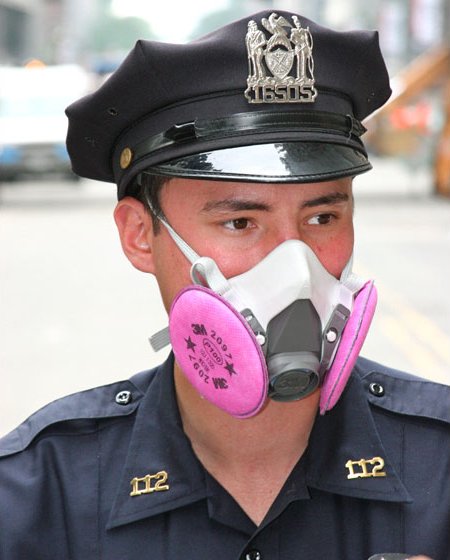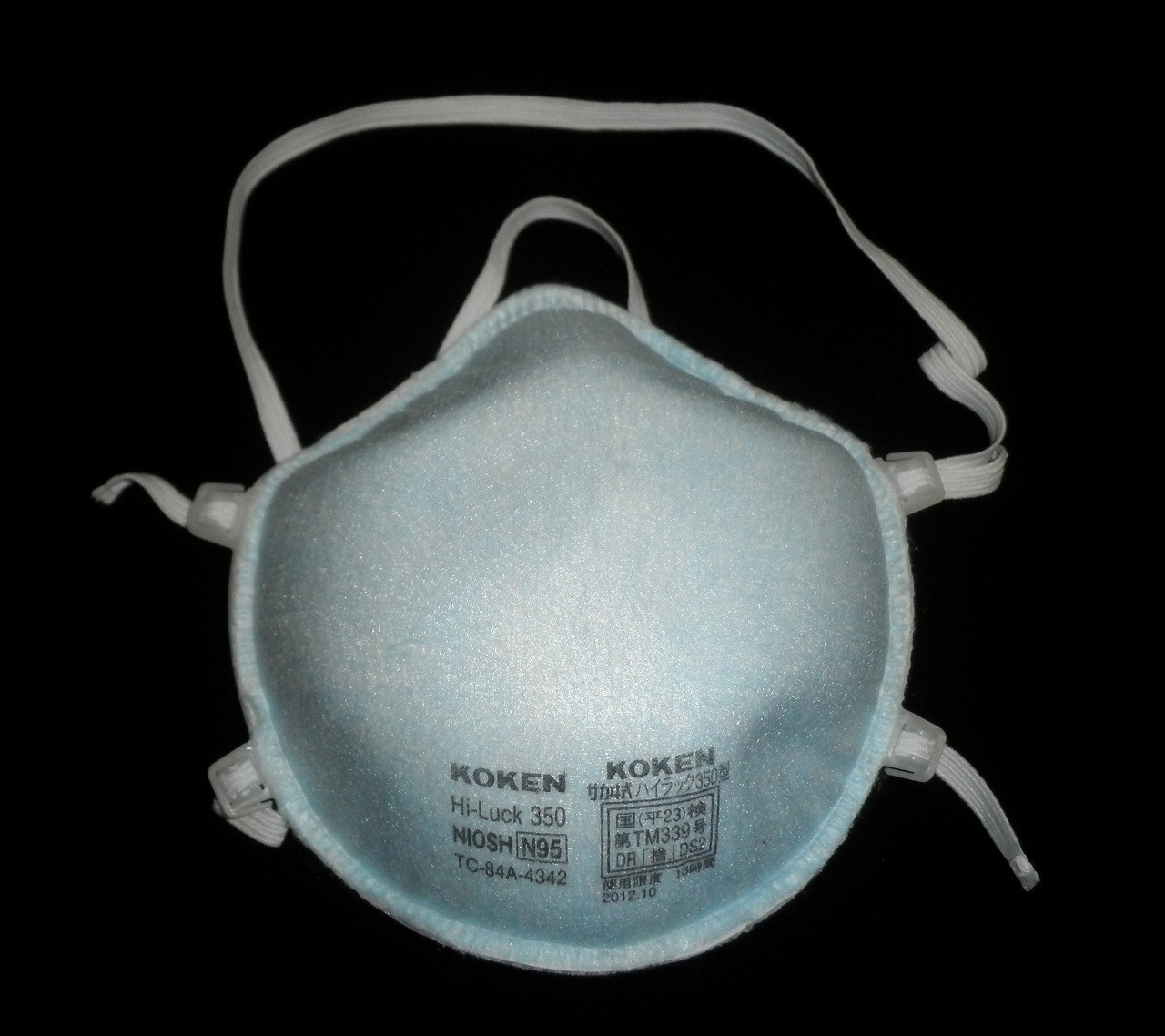|
Powered Air-purifying Respirator
A powered air-purifying respirator (PAPR) is a type of respirator used to safeguard workers against contaminated air. PAPRs consist of a headgear-and-fan assembly that takes ambient air contaminated with one or more type of pollutant or pathogen, actively removes (filters) a sufficient proportion of these hazards, and then delivers the clean air to the user's face or mouth and nose. They have a higher assigned protection factor than filtering facepiece respirators such as N95 masks. PAPRs are sometimes called positive-pressure masks, blower units, or just blowers. Description The modularity of PAPRs allows them to be customized for different working environments. Regardless of type, a PAPR consists of: * some kind of headgear (mask or hood), * a powered (motor-driven) fan which forces incoming air into the device, * a filter (or multiple filters) for delivery to the user for breathing, and * a battery or other power source. The mask may be hard and tight-fitting, or f ... [...More Info...] [...Related Items...] OR: [Wikipedia] [Google] [Baidu] |
Elastomeric Respirator
Elastomeric respirators, also called reusable air-purifying respirators, seal to the face with elastomeric material, which may be a natural or synthetic rubber. They are generally reusable. Full-face versions of elastomeric respirators seal better and protect the eyes. Elastomeric respirators consist of a reusable mask that seals to the face, with exchangeable filters. Elastomeric respirators can be used with chemical cartridge filters that remove gases, mechanical filters that retain particulate matter, or both. As particulate filters, they are comparable (or, due to the quality and error-tolerance of the elastomeric seal, possibly superior (free fulltext)) to filtering facepiece respirators such as N95 respirators and FFP masks. Elastomeric air-purifying respirators are designed to be safely reused for years. Provided the cartridge integrity and filter have not been compromised, current practice shows that the filters could be used for at least one year. Some, but not all, ... [...More Info...] [...Related Items...] OR: [Wikipedia] [Google] [Baidu] |
Dust Mask
A dust mask is a flexible paper pad held over the nose and mouth by elastic or rubber straps for personal comfort against non-toxic nuisance dusts. They are not intended to provide protection from toxic airborne hazards. The European FFP1 mask, the lowest-grade mechanical filter respirator available in the jurisdiction, is also used as a dust mask. Dust masks are used in environments with dusts encountered during construction or cleaning activities, such as dusts from drywall, brick, wood, fiberglass, silica (from ceramic or glass production), or sweeping. A dust mask can also be worn in environments with allergens such as tree and grass pollen. A dust mask is also used to prevent the wearer from inhaling dust or sand in a dust storm. Description A dust mask is worn in the same fashion as a filtering facepiece respirator or surgical mask, but it is dangerous to confuse them because they each protect against specific airborne dangers. Using the wrong mask for a job can ... [...More Info...] [...Related Items...] OR: [Wikipedia] [Google] [Baidu] |
Spray Paint
Aerosol paint (commonly spray paint) is paint that comes in a sealed, pressurized container and is released in an aerosol spray when a valve button is depressed. Aerosol painting is one form of spray painting; it leaves a smooth, even coat, unlike many traditional rolled and brushed paints. Standard-sized cans are lightweight, portable, inexpensive, and easy to store. Aerosol primer can be applied directly to bare metal and many plastics. Graffiti artists are known to use spray paint because the medium is quick, permanent, and portable. The origin of the product, however, dates back to 1949, when it was designed for the very practical purpose of applying aluminum paint coatings to radiators. History In 1949, Edward H. Seymour, of Sycamore, Illinois, added paint to existing spray can technology at his wife Bonnie's suggestion. It was initially designed to demonstrate an aluminum paint he developed. His patent was awarded in 1951. Most aerosol paints also have a metal, marbl ... [...More Info...] [...Related Items...] OR: [Wikipedia] [Google] [Baidu] |
Organic Compound
In chemistry, organic compounds are generally any chemical compounds that contain carbon-hydrogen or carbon-carbon bonds. Due to carbon's ability to catenate (form chains with other carbon atoms), millions of organic compounds are known. The study of the properties, reactions, and syntheses of organic compounds comprise the discipline known as organic chemistry. For historical reasons, a few classes of carbon-containing compounds (e.g., carbonate salts and cyanide salts), along with a few other exceptions (e.g., carbon dioxide, hydrogen cyanide), are not classified as organic compounds and are considered inorganic. Other than those just named, little consensus exists among chemists on precisely which carbon-containing compounds are excluded, making any rigorous definition of an organic compound elusive. Although organic compounds make up only a small percentage of Earth's crust, they are of central importance because all known life is based on organic compounds. Liv ... [...More Info...] [...Related Items...] OR: [Wikipedia] [Google] [Baidu] |
High-efficiency Particulate Air
HEPA (, high-efficiency particulate air) filter, also known as high-efficiency particulate absorbing filter and high-efficiency particulate arrestance filter, is an efficiency standard of air filters. Filters meeting the HEPA standard must satisfy certain levels of efficiency. Common standards require that a HEPA air filter must remove—from the air that passes through—at least 99.95% ( ISO, European Standard) or 99.97% (ASME, U.S. DOE) of particles whose diameter is equal to 0.3 μm, with the filtration efficiency increasing for particle diameters both less than and greater than 0.3 μm. HEPA filters capture pollen, dirt, dust, moisture, bacteria (0.2-2.0 μm), virus (0.02-0.3 μm), and submicron liquid aerosol (0.02-0.5 μm). Some microorganisms, for example, ''Aspergillus niger'', ''Penicillium citrinum'', ''Staphylococcus epidermidis'', and ''Bacillus subtilis'' are captured by HEPA filters with photocatalytic oxidation (PCO). A HEPA filter is a ... [...More Info...] [...Related Items...] OR: [Wikipedia] [Google] [Baidu] |
Woodwork
Woodworking is the skill of making items from wood, and includes cabinet making (cabinetry and furniture), wood carving, joinery, carpentry, and woodturning. History Along with stone, clay and animal parts, wood was one of the first materials worked by early humans. Microwear analysis of the Mousterian stone tools used by the Neanderthals show that many were used to work wood. The development of civilization was closely tied to the development of increasingly greater degrees of skill in working these materials. Among early finds of wooden tools are the worked sticks from Kalambo Falls, Clacton-on-Sea and Lehringen. The spears from Schöningen (Germany) provide some of the first examples of wooden hunting gear. Flint tools were used for carving. Since Neolithic times, carved wooden vessels are known, for example, from the Linear Pottery culture wells at Kückhofen and Eythra. Examples of Bronze Age wood-carving include tree trunks worked into coffins from northern ... [...More Info...] [...Related Items...] OR: [Wikipedia] [Google] [Baidu] |
Dust
Dust is made of fine particles of solid matter. On Earth, it generally consists of particles in the atmosphere that come from various sources such as soil lifted by wind (an aeolian process), volcanic eruptions, and pollution. Dust in homes is composed of about 20–50% dead skin cells. The rest, and in offices, and other human environments is composed of small amounts of plant pollen, human hairs, animal fur, textile fibers, paper fibers, minerals from outdoor soil, burnt meteorite particles, and many other materials which may be found in the local environment. Atmospheric Atmospheric or wind-borne fugitive dust, also known as ''aeolian dust'', comes from arid and dry regions where high velocity winds are able to remove mostly silt-sized material, deflating susceptible surfaces. This includes areas where grazing, ploughing, vehicle use, and other human behaviors have further destabilized the land, though not all source areas have been largely affected by an ... [...More Info...] [...Related Items...] OR: [Wikipedia] [Google] [Baidu] |
Matter
In classical physics and general chemistry, matter is any substance that has mass and takes up space by having volume. All everyday objects that can be touched are ultimately composed of atoms, which are made up of interacting subatomic particles, and in everyday as well as scientific usage, "matter" generally includes atoms and anything made up of them, and any particles (or combination of particles) that act as if they have both rest mass and volume. However it does not include massless particles such as photons, or other energy phenomena or waves such as light or heat. Matter exists in various states (also known as phases). These include classical everyday phases such as solid, liquid, and gas – for example water exists as ice, liquid water, and gaseous steam – but other states are possible, including plasma, Bose–Einstein condensates, fermionic condensates, and quark–gluon plasma. Usually atoms can be imagined as a nucleus of protons and neutrons, ... [...More Info...] [...Related Items...] OR: [Wikipedia] [Google] [Baidu] |
NIOSH Air Filtration Rating
The NIOSH air filtration rating is the U.S. National Institute for Occupational Safety and Health (NIOSH)'s classification of filtering respirators. The ratings describe the ability of the device to protect the wearer from solid and liquid particulates in the air. The certification and approval process for respiratory protective devices is governed by Part 84 of Title 42 of the Code of Federal Regulations (42 CFR 84). Respiratory protective devices so classified include air-purifying respirators (APR) such as filtering facepiece respirators and chemical protective cartridges that have incorporated particulate filter elements. The classifications only cover the filtration of particles or aerosols, not the air-purifying respirator's ability to remove chemical gasses and vapors from air, which is regulated under 42 CFR 84 Subpart L. For more information see Cartridge (respirator). The classifications assume that the respirator is properly fitted. NIOSH classifications NIO ... [...More Info...] [...Related Items...] OR: [Wikipedia] [Google] [Baidu] |






